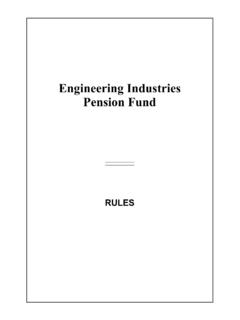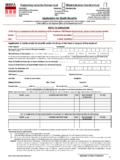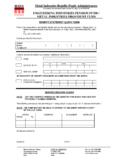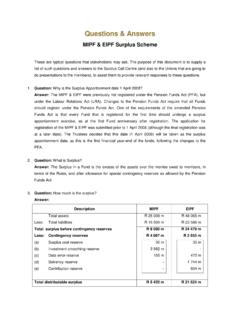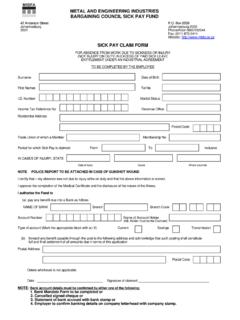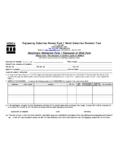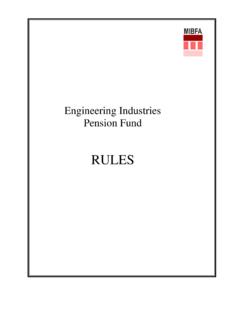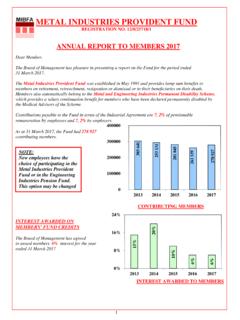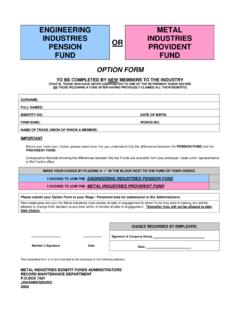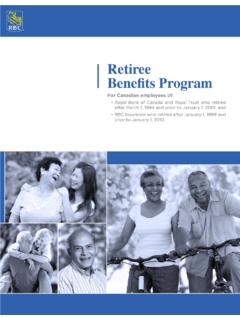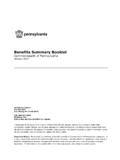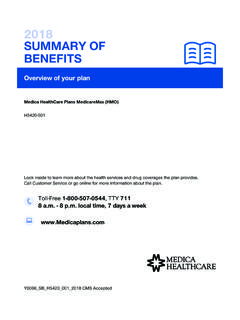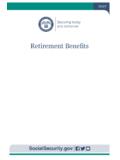Transcription of Surplus Apportionment Information Booklet - MIBFA
1 Page 1 Engineering Industries Pension Fund Surplus Apportionment Information Booklet Page 2 Index 1. Introduction Page 3 2. History of EIPF Page 3 3. Stakeholders Page 4 4. Actions by the Board of Trustees to obtain all the former member data Page 5 5. Financial position of the EIPF prior to the Surplus Apportionment Page 5 6. Surplus deemed improperly utilised by the employer Page 5 7. Contingency reserves Page 5 8. Surplus available for Apportionment Page 6 9. Prescribed minimum benefits : Former members Page 7 10. Prescribed minimum benefits : Pensioners Page 8 11. Remaining Surplus Page 9 12.
2 Summary of the Apportionment as at 1 April 2008 Page 11 13. Statements by the Former Member Representative Page 11 14. Application of Surplus allocation amounts Page 12 15. In summary Page 13 16. Next steps required from Stakeholders Page 13 Annexure 1 Deaths on or after 1 April 2008 Page 14 Page 3 Engineering Industries Pension Fund ( the EIPF ) (12/8/5040) Surplus Apportionment scheme as at 1 April 2008 Report by the Trustees 1. Introduction The Pension Funds Second Amendment Act, 2001 (the Act) requires all pension funds to allocate any Surplus on a basis as set out in the Act.
3 The Surplus Apportionment date for the Engineering Industries Pension Fund (also referred to as the EIPF ) is 1 April 2008. The purpose of this document is to inform all stakeholders on the Surplus Apportionment scheme, as approved by the Trustees. 2. History of the EIPF A fund known as the Metal Industries Group Life and Provident Fund (also referred to as the MIGLPF ) was established effective 29 July 1957. During 1975 the fund converted to a defined benefit structure. On 31 March 1990 the MIGLPF changed its name to the Engineering Industries Pension Fund (EIPF). On 1 May 1991 the Metal Industries Provident Fund (MIPF) was established as a defined contribution provident fund.
4 EIPF members were given the option to transfer to the MIPF during the period 1 October 1993 to 28 February 1994. A large number of the members of the EIPF elected to transfer to the MIPF. A separate fund, known as the Metal Industries Group Pension Fund (also referred to as the MIGPF ) was established effective 7 February 1966. Members of the MIGPF were given the option to transfer to the MIPF with effect from 1 May 1991. A large number of the members of the MIGPF elected to transfer to the MIPF. On 1 January 1995 the remaining members of the MIGPF were transferred into the EIPF and the MIGPF ceased to exist.
5 In terms of the law, former members of the MIGPF who exited before 1 January 1995 (the date when the MIGPF merged into the EIPF) are not regarded as stakeholders in the Surplus Apportionment scheme for the EIPF as they never contributed and belonged to the EIPF. Page 4 3. Stakeholders The following parties are considered as stakeholders in terms of the Act and must be included in the Surplus Apportionment scheme as at 1 April 2008: Former members of the EIPF [a total of 202 810 qualifying former members] These are all members who left the EIPF (previously known as the MIGLPF) over the period 1 January 1980 (the date specified in the Act) until 31 March 2008 and who previously received a benefit from the EIPF, that is, all withdrawals, transfers and retirements during this period.
6 Active members as at 31 March 2008 [a total of 30 536 active members] These are all members who were members of the EIPF as at 31 March 2008. If any of these members withdrew, died or retired on/after 1 April 2008 they are still taken into account as active members. Pensioners as at 31 March 2008 [a total of 41 236 pensioners] These are all persons as at 31 March 2008 who receive a pension income from the EIPF. Paid-up members as at 31 March 2008 [a total of 1 478 474 paid-up members] These are all members who left the EIPF before 31 March 2008 whose benefits have not yet been claimed and/or paid.
7 Some of these members will only become entitled to their accumulated fund benefits at a future date (once they reached retirement age). Others have already become entitled to benefits, but have not claimed the benefits as such. In the actuarial valuations the value of the paid-up members benefits are reserved for as part of the liabilities of the EIPF. The various participating Employers The following parties are legally not regarded as stakeholders of the EIPF and have been excluded from the Surplus Apportionment scheme. All former members who died before or on 31 March 2008. All former members who exited before 1 January 1980 (date specified in the Act) and received their benefits in terms of the Rules of the EIPF.
8 All pensioners who died before or on 31 March 2008. All members who entered the EIPF on or after 1 April 2008. The Trustees have appointed Mr David Levy as Former Member Representative to represent the interests of former members in the discussions regarding the Surplus Apportionment scheme. 4. Actions by the Board of Trustees to obtain all the former member data Page 5 MIBFA , the Administrator of the EIPF, provided the membership data as recorded on their systems. The Trustees also placed advertisements in various newspapers, both on a national and regional level, to invite former members to come forward and register as a stakeholder in the Surplus Apportionment scheme.
9 Similarly, broadcasts were made on several community radio stations to make people aware of the Surplus Apportionment exercise. Posters and pamphlets were distributed to the various participating employers and unions. A special Surplus Call Centre was established to deal with all the Surplus enquiries and registrations. The Unions will be hosting Information sessions to inform member stakeholders of the Surplus Apportionment scheme. Please contact your Union representative to get more detail in this regard. 5. Financial position of the EIPF prior to the Surplus Apportionment An actuarial valuation of the assets and the liabilities of the EIPF was completed as at 1 April 2008.
10 The valuation indicated a total Surplus of R 24 479 million, prior to the investigation of any improper use of Surplus by the employers (refer to Section 6 of this Booklet ) and prior to the establishment of any contingency reserves (refer to Section 7 of this Booklet ). 6. Surplus deemed improperly utilised by the employer Section 15B(6) of the Act stipulated four instances of utilisation of Surplus which are deemed as being improperly utilised and requires all pension funds to investigate such usages of Surplus . An investigation into the financial history of the EIPF over the period 1 January 1980 (date specified in the Act) up to the Surplus Apportionment date of 1 April 2008 was done with the aim of determining whether any Surplus was utilized improperly by the employers, as defined in Section 15B(6) of the Act.
